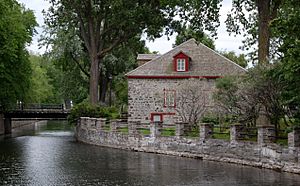The Fur Trade at Lachine National Historic Site facts for kids

The Fur Trade at Lachine and original Lachine Canal as in 1820s
|
|
| Location | Lachine in Montreal, Quebec, Canada. |
|---|---|
| Type | history museum |
| Official name: The Fur Trade at Lachine National Historic Site | |
| Designated: | 1970 |
The Fur Trade at Lachine National Historic Site is a special historic building. It is located in Lachine, a part of Montreal, Quebec, Canada. This site sits at the western end of the famous Lachine Canal. It is recognized as a National Historic Site of Canada.
For hundreds of years, this spot was super important for the fur trade. Brave travelers called voyageurs started their long canoe trips from here. They carried goods deep into North America. The powerful Lachine Rapids nearby stopped big ships from going further west on the Saint Lawrence River. This made Lachine a key transfer point.
In 1803, a strong stone warehouse was built here. It was used to store all the furs collected from trading. Today, this warehouse is a Parks Canada museum. It teaches visitors about the exciting history of this place. It was a vital starting and ending point for many fur trading adventures.
Contents
The Story of the Fur Trade
The city of Montreal was the main starting point for almost all canoe routes heading west. This is where furs were moved from canoes to ships. Also, trade goods were transferred from ships to canoes. The western end of Montreal Island was a natural place for this transfer. Goods could be carried about nine miles by cart around the Lachine Rapids.
Journeys of the Voyageurs
Canoes usually left Lachine in May. They would return with furs in August. These trips were long and challenging. The Northwest Company, a big fur trading business, built the stone warehouse in 1803. This building was used for storing furs until 1859.
From Warehouse to Museum
After 1859, the warehouse was sold. The Sisters of Sainte Anne used it as a home for their employees. The Lachine Canal was built around the rapids in 1825. This canal made it easier for ships to bypass the dangerous rapids. A famous person named Sir George Simpson (administrator) had a large house across the canal from the warehouse. His house was taken down in 1880.
Parks Canada bought the old warehouse in 1977. They worked to restore it and opened it as a museum in 1985. Today, it helps us remember the important role Lachine played in Canada's history.
Museum Connections
The Fur Trade at Lachine National Historic Site is connected with several important groups. These include the Canadian Museums Association. It also works with the Canadian Heritage Information Network. Finally, it is part of the Virtual Museum of Canada. These connections help the museum share its history with more people.

